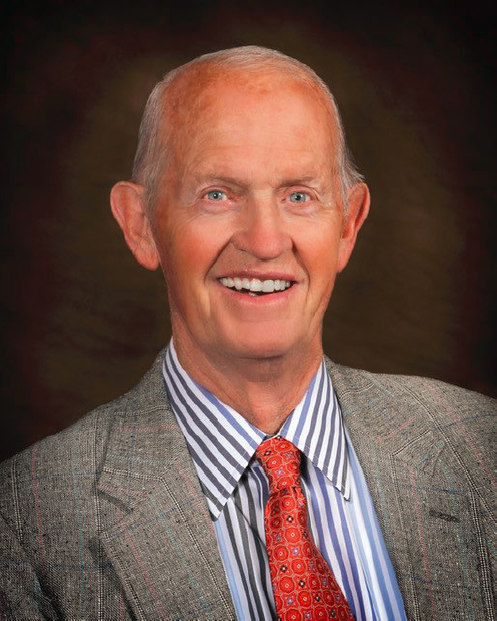DAVID A. DUKE
1935–2017
Elected in 1992
“For outstanding contributions in research, development, and commercialization of innovative glass and ceramic products.”
BY DAVID MORSE AND PAMELA F. STROLLO
DAVID ALLEN DUKE died October 9, 2017, at the age of 81, in Salt Lake City, Utah, which is where he was born November 26, 1935, the youngest of six children of Beatrice (née Taylor) and Otto Duke. He attended Bryant Junior High and Salt Lake East High before enrolling at the University of Utah in 1953. He married his high school sweetheart, Hanne Jensen, in 1955 in the Salt Lake City Temple of the Church of Jesus Christ of Latter-day Saints.
After earning his bachelor of science in geology (1957), master of science in geoceramics (1959), and PhD in ceramics (1962), he accepted a position at Corning Glass Works as a research scientist and moved his family to Corning, New York. He was recognized as a brilliant researcher and talented manager during his long career with the company, which in 1968 sent him to Harvard Business School’s Advanced Management Development Program. Upon his return, he was given the opportunity to grow and run several of Corning’s businesses.
In the early 1970s he was the general manager of Corning’s Industrial Products Business, where he ran a management team with Dick Dulude and Charles “Skip” Deneka. These leaders were tasked with capitalizing on Corning’s new extrusion process, which produced the honeycomb ceramic structure ultimately named Celcor.
They took on multiple challenges to make Corning the solution of choice for automakers rushing to meet new US emissions regulations for their 1975 models: first ramping up production in time to capture business, then successfully demonstrating that the ceramic substrate provided the function that prospective customers needed, and, finally, ensuring that Corning could produce millions of units each year reliably and at an affordable price.
An around-the-clock development effort ensued, with an estimated three-quarters of Corning’s Research and Development Center at Sullivan Park dedicated to Celcor. With no customer commitment, Corning broke ground in 1973 on a production plant in Erwin, NY. The bet worked. The facility shipped its first products in 1974, just months ahead of automakers’ deadlines, and the rest was history. Celcor accounted for more than $100 million in profitable sales in its first year. It is the technology of catalytic convertors, diesel soot filters, and gas particulate filters worldwide to this day.
Not long after this success, Dave became general manager of Corning’s new Telecommunications Products Division, which had six employees, virtually no sales, and the goal of creating an optical waveguide business. Dave oversaw some big risks to commercialize what would become Corning’s optical-fiber business. However, the company needed to invest significantly in perfecting its manufacturing process. Mirroring the path they took with Celcor, Dave and others decided to move from a pilot operation to a full-fledged plant before Corning ever received a sizable order for fiber. The orders did come, Corning continued honing its capabilities under great pressure, and this area became one of its largest businesses. Optical communications via fiber networks led to the internet and all the changes in communications and data transfer that changed the world.
After 10 years focused on fiber commercialization, Dave became vice chair, directing Corning’s R&D organization. He applied what he had learned from the experience with Celcor and optical fiber to help the company establish and maintain a focus on anticipating and innovating for the future.
By the time he retired in 1996, as vice chair of the board and chief technology officer, Dave had 10 patents, including for products such as Corelle dinnerware. He had also, on behalf of the company, accepted the 1994 National Medal of Technology and Innovation from the president of the United States.
He was elected to the NAE in 1992, and in 1997 received the Earle B. Barnes Award in Chemical Research Management from the American Chemical Society. He was a member of the Engineering National Advisory Committee of the University of Utah College of Engineering, and for the National Academies served on the Committee on Japan (1993–99) and the Competitiveness Task Force: Strategies for Maximizing US Interests in Scientific and Technological Relations with Japan (1993–97).
Dave was an active member of the Church of Jesus Christ of Latter-day Saints, serving in the church throughout his life, including as president of the Elmira, NY, branch; bishop of the Elmira ward; and president of the Durban, South Africa, mission (1998–2001).
He was known for his love of others, making lifelong friendships with nearly everyone he met. He served tirelessly to help others, mentor colleagues at work, counsel families, and encourage youth to achieve personal and professional success through education, goal setting, and life planning.
Dave was active and athletic throughout his life. He developed a love of golf as a youth working as a caddy and groundskeeper at the Salt Lake Country Club and golfed to the very end, including at Augusta National. He also loved to fish. In Corning he played on intramural and city league teams in basketball, fast-pitch softball, volleyball, tennis, swimming, horseshoes, and bowling, and coached many youth sports teams.
He is survived by his wife of 62 years, Hanne; their four children: Katherine (Robert) Shumway, Michael (Catherine), Deborah, and John (Cessily); and 20 grandchildren.





